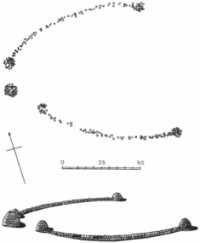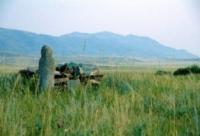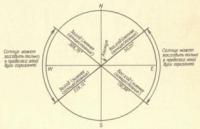You are here
Mysteries of ancient sanctuary of Turks Talsai.



Ancient sanctuaries in Kazakhstan.
“3 miles from the city of Garbian (Gurbayan) there are silver mines. The benefits from them are high... A lot of (silver) is extracted from these mines. Shash merchants go to them with goods for exchange, buy from them many camels with a large amount of goods (i.e. silver) and export them to all countries.”
Arab geographer al-Idrisi. "Nuzhat al-Mushtaq."
Monuments of Middle Ages Ulytau.
The ancient sanctuary of Talsai is located at an altitude of 450 meters above sea level, located in the interfluve of Talsai and Sary-Kengir, north of the Konyrzhal ridge, 180 meters from the drying, seasonal Adyl riverbed, which originates from the springs of the same name, 3.5 kilometers northeast of on the right bank of the Talsay River, 38.5 kilometers northeast of village of Malshybay, in Ulytau district of region of same name.
...A unique ancient sanctuary of the Turks, which hid centuries-old mysteries, is the archaeological complex of Talsay, located in the eastern part of the Sarykengir River basin. Visual observations revealed that the ridge of granite plateaus and the valleys of the Sarykengir River are saturated with monuments from different periods of the history of Ulytau: the Neolithic, Bronze, Early Iron Age, Early Middle Ages, but in these monuments the culture of the nomadic Turks found the most vivid expression.
Stone mounds, memorial fences, stone sculptures standing in originally established places, petroglyphs on the rocks, being a natural part of the landscape, at the same time represent milestones in the history of this land.
“This is such a wonderful antiquity that it is difficult to find anywhere else,” wrote the Swedish scientist F. Stralenberg (1676 - 1747) about the monuments of Ulytau.
As a result of a targeted survey during the expedition of the territory of the tract, monuments of the Turkic era were identified, typologically different and belonging to different periods of the Turkic era. The most notable among them are mounds and orgades with stone sculptures placed on the objects themselves or next to them. In some cases, two sculptures were recorded.
All surveyed monuments structurally consist of the following structures: mounds, a memorial complex and a stone statue. This kind of monument was located separately in one of the picturesque places, probably marking the territory of the clan’s habitat.
A number of such ritual complexes made up the whole sanctuary, which had a temple character. Similar sanctuaries created by the Turks throughout the Eurasian area seem to show the ways of formation and settlement of the ethnic group.
Complex work in the unique archaeological complex of Talsay allows us to solve a number of issues related to the genesis of the material culture of the Turkic ethnic group. The study of this archaeological complex will become a genuine source of ideas in the matter of reconstructing the worldview and worldview of the Turks who inhabited Ulytau.
The stone sculptures in this ancient open-air sanctuary are a striking example of the monumental art of nomads and reliable ethnographic material. Nearby there is an ancient quarry where stonemasons mined granite.
This allows us to judge that granite sculptures and many granite fences were made here, which were installed in many places in Ulytau. Ancient craftsmen selected suitable places to mine granite, processed it and transported it over long distances.
The funeral rite of nomads is characterized by the installation on the mounds or next to them of statues depicting a standing person. Thus, the Talsay archaeological complex includes; stone sculptures, an ancient quarry, “mounds with mustaches” of the Tasmolin culture (2800 years old), free-standing stones - menhirs, which according to researchers belong to the Bronze Age (III - II millennium BC), fences of the Turkic period (VI - VIII century AD).
Next to the stone sculptures, mounds and mounds of stone were built, which in the scientific literature received the not entirely successful name of mounds “with mustaches.” Mounds “with mustaches” are a complex burial complex of stone structures, found in several variants.
It consists of a large main mound and a small mound of small height adjoining it on the eastern side or located at a considerable distance and extending from it to the east there are two stone ridges 1.5 - 2 meters wide and from 20 to 200 meters or more in length. In this case, in the Talsay complex, the mounds “with mustaches” are 160 meters long and the stone ridges have the shape of semi-arcs, at the beginning and end limited by round stone structures of the mound type.
Thus, the concept of mounds “with mustaches” includes three components, or elements of artificial structures: a large mound with a human burial, a small one with a horse burial and a clay vessel, and stone ridges.
Consideration of any component part in isolation ultimately leads to a misunderstanding of the entire complex as a whole. This is precisely the main mistake of researchers who defined mounds “with mustaches” as monuments for ritual purposes only.
Аccording to scientist M.K. Kadyrbaev, the mounds “with mustaches” should be considered as a single complex, consisting of the main burial in a large mound and related structures of a ritual nature, “small mounds containing the burial of a horse or part of it in combination with arched stone ridges oriented by their open end to the east, towards the rising Sun, “are of a purely ritual nature and are a reflection of the cult - most likely - solar,” while he appeals to the message of Herodotus:
- “Of the gods, only the Sun is revered, to whom horses are sacrificed. The meaning of this sacrifice is that the fastest of all gods deserves the fastest animal."
Balkhash researcher P.I. Marikovsky, encountering similar mounds “with mustaches” in the Balkhash region, proposed to consider them as archaeoastronomical objects, oriented with their points and elements to certain planets and luminaries located at specific points in time at characteristic points in the sky.
We invite future researchers of the mysterious mounds with mustaches to read the monumental work “The Sun, the Moon and Ancient Stones” by J. Wood. In the archaeological complex of Talsai, between stone sculptures and barrows with mustaches, lies a single granite block more than four meters high.
This block was probably in a vertical position. Such ancient vertical stone pillars are called menhirs. Menhirs are actually the first authentically man-made structures that have survived to this day. Until the XIXth century, archaeologists did not have sufficient data about their origin.
The development of methods of radiocarbon analysis and dendrochronology has made it possible to more accurately determine their age: mainly menhirs belong to the cultures of the Neolithic, Copper and Bronze Ages.
Menhirs could have been used for a variety of purposes that are currently unknown and may never be determined. Among the likely purposes are cultic, memorial, solar-astronomical and as signs of energetic “places of power”.
Despite the fact that the tradition of setting stones vertically is one of the oldest, it is also one of the most sustainable. Humanity still erects stone steles in honor of certain events or intentions. Our ancient ancestors left us many secrets and today there are more guesses than answers.
Therefore, having chosen the time, we should come to the unique archaeological complex of Talsai and see for ourselves, with our own eyes, these unique monuments left by our ancestors.
The study of the Talsay archaeological complex continues...
Geographic coordinates of Talsay archaeological complex: N48°30'25 E68°16'03
Authority and photos by:
Director of Historical and Industrial Museum named after K.I. Satpayeva Kenzhal Balkenov.







